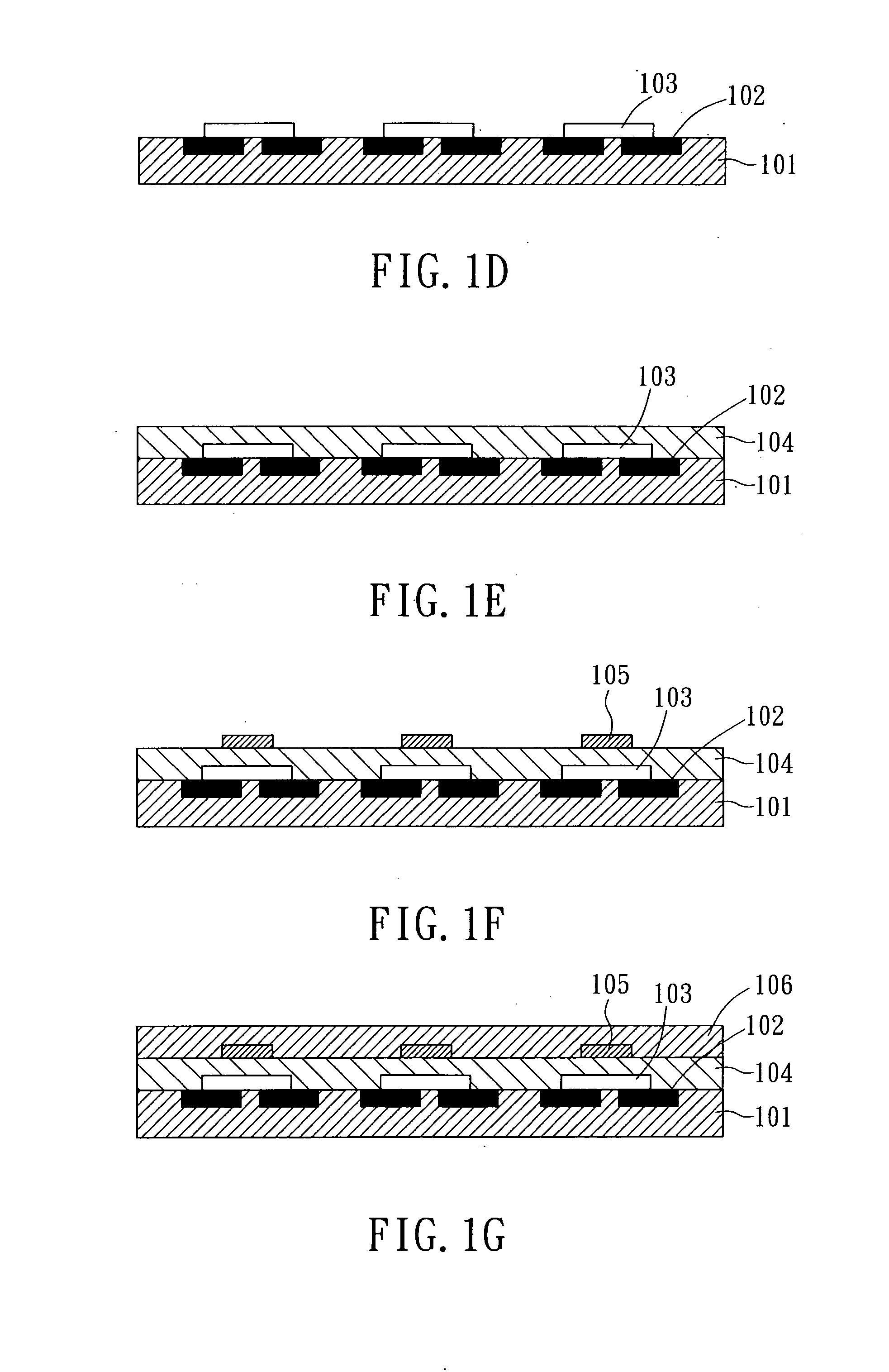Method for manufacturing organic thin-film transistor with plastic substrate
a technology of organic thin film transistor and plastic substrate, which is applied in the manufacture of final products, basic electric elements, solid-state devices, etc., can solve the problems of plastic substrate, long fabrication time, and inability to use otft fabrication, and achieve the effect of reducing material cost and simplifying the fabrication procedur
- Summary
- Abstract
- Description
- Claims
- Application Information
AI Technical Summary
Benefits of technology
Problems solved by technology
Method used
Image
Examples
first embodiment
[0023] Please refer to FIG. 1A to FIG. 1G, which illustrate schematic diagrams showing steps in the method for manufacturing an organic thin-film transistor with a plastic substrate according to a first embodiment of the present invention. These steps are described hereinafter.
[0024] As shown in FIG. 1A, a mold 100 is provided with a relief printing structure 1001, which is implemented by LIGA (Lithographie GalVanoformung Abformung), resulting in higher aspect ratio and lower surface roughness. In LIGA process, the mold 100 is coated by a dry film or a polymer layer (not shown) of 10 μm˜1000 μm in thickness. Laser process is then performed on the dry film or the polymer layer so as to form the relief printing structure 1001.
[0025] As shown in FIG. 1B, the plastic substrate 101 is imprinted using the mold 100 so as to define the source / drain electrode regions 1010 as well as the channel length on the plastic substrate 101. In the first embodiment, the plastic substrate 101 comprise...
second embodiment
[0028] Please refer to FIG. 2A to FIG. 2G, which illustrate schematic diagrams showing steps in the method for manufacturing an organic thin-film transistor with a plastic substrate according to a second embodiment of the present invention. These steps are described hereinafter.
[0029] As shown in FIG. 2A, a mold 200 is provided with a relief printing structure 2001, which is implemented by LIGA (Lithographie GalVanoformung Abformung), resulting in higher aspect ratio and lower surface roughness.
[0030] As shown in FIG. 2B, the plastic substrate 201 is imprinted using the mold 200 so as to define the gate electrode regions 2010 on the plastic substrate 201. In the second embodiment, the plastic substrate 201 comprises polymer materials having —CH3 or —NH2 functional groups such as PMMA (poly-methylmethacrylate), mCOC (metallocenebased cyclic olefin copolymer), etc. The plastic substrate 201 is formed by imprinted without conventional photo-lithography and etching so as to reduce fab...
third embodiment
[0033] Please refer to FIG. 3A to FIG. 3G, which illustrate schematic diagrams showing steps in the method for manufacturing an organic thin-film transistor with a plastic substrate according to a third embodiment of the present invention. These steps are described hereinafter.
[0034] As shown in FIG. 3A, a mold 300 is provided with a relief printing structure 3001, which is implemented by LIGA (Lithographie GalVanoformung Abformung), resulting in higher aspect ratio and lower surface roughness.
[0035] As shown in FIG. 3B, the plastic substrate 301 is imprinted using the mold 300 so as to define the gate electrode regions 3010 on the plastic substrate 301. In the third embodiment, the plastic substrate 301 comprises polymer materials having —CH3 or —NH2 functional groups such as PMMA (poly-methylmethacrylate), mCOC (metallocenebased cyclic olefin copolymer), etc. The plastic substrate 301 is formed by imprinted without conventional photo-lithography and etching so as to reduce fabri...
PUM
 Login to View More
Login to View More Abstract
Description
Claims
Application Information
 Login to View More
Login to View More - R&D
- Intellectual Property
- Life Sciences
- Materials
- Tech Scout
- Unparalleled Data Quality
- Higher Quality Content
- 60% Fewer Hallucinations
Browse by: Latest US Patents, China's latest patents, Technical Efficacy Thesaurus, Application Domain, Technology Topic, Popular Technical Reports.
© 2025 PatSnap. All rights reserved.Legal|Privacy policy|Modern Slavery Act Transparency Statement|Sitemap|About US| Contact US: help@patsnap.com



